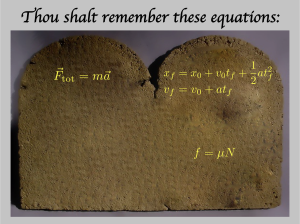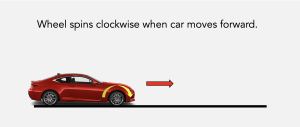27 Static Friction
Friction is weird.
Exercise 27.1: Static Friction
When we added rocks to the box, we also increased the normal force between the box and the table. Thus, the maximum frictional force must increase as the normal force between the two objects increases, i.e.
![]() .
.
Here, ![]() is the maximum possible value of the static frictional force, and the coefficient
is the maximum possible value of the static frictional force, and the coefficient ![]() is called the static frictional coefficient. The equation makes sense: squeezing objects into each other makes it harder for them to slip.
is called the static frictional coefficient. The equation makes sense: squeezing objects into each other makes it harder for them to slip.
In summary-
- When two objects touch, and you try to push one of the objects, static friction between the objects will magically appear to prevent “slippage”
- The static frictional force will also magically increase as needed, but only to a point.
- The maximum static frictional force increases as the normal force between the two objects increases.
I think it’s wild that friction can just “do whatever needs to be done” to prevent slippage. Be that is it may, that’s how the world operates, so we will now promote these statements to the “law of static friction.” Consequently, the law of static friction makes it into our tablets. However, note that the equation ![]() is already in our tablets: this equation describes kinetic friction. Thus, we will just keep one equation in our tablets:
is already in our tablets: this equation describes kinetic friction. Thus, we will just keep one equation in our tablets: ![]() . It is up to us to remember that when there is rubbing,
. It is up to us to remember that when there is rubbing, ![]() is the kinetic frictional force, whereas when there is no slipping, then
is the kinetic frictional force, whereas when there is no slipping, then ![]() is the maximum static frictional force.
is the maximum static frictional force.
In other words, when it comes to frictional forces, the static and kinetic frictional forces are described by the same equation, but the interpretation of that equation in English is different depending on whether friction is kinetic (rubbing) or static (no slipping).

Let us now put this newfound knowledge to use.
Exercise 27.2: Sliding block
A block of mass ![]() rests on a board of length
rests on a board of length ![]() . The board starts horizontal, but you proceed to slowly raise one end of the board. When the boards makes an angle
. The board starts horizontal, but you proceed to slowly raise one end of the board. When the boards makes an angle ![]() with the horizontal, the block begins to slide. Find the static frictional coefficient between the block and the board.
with the horizontal, the block begins to slide. Find the static frictional coefficient between the block and the board.
Exercise 27.3: Box in a car.
You throw a box of mass ![]() in the trunk of your car. You get in your car, turn it on, and gently press the gas. The car accelerates forward with acceleration
in the trunk of your car. You get in your car, turn it on, and gently press the gas. The car accelerates forward with acceleration ![]() , and the box accelerates along with the car: no slippage. If you accelerate fast enough, however, the box will “slide backwards.” The maximum possible acceleration you can have without the box sliding backwards is
, and the box accelerates along with the car: no slippage. If you accelerate fast enough, however, the box will “slide backwards.” The maximum possible acceleration you can have without the box sliding backwards is ![]() .
.
What is the frictional coefficient of the box with the trunk?
Let’s make sure the lesson from the previous problem is clear:
The important thing here is that static friction tries to prevent slippage. This is not at all the same thing as saying that static friction tries to keep objects still. In the problem above, the box needs to move with the car in order for it not to slip, so the frictional force actually pushes the box to get it going! In other words, a static frictional force can make objects move!
Friction makes things move!
Consider a car standing still at a red light. The light turns green. You press on the gas, and the car accelerates forward.
Let’s prove this by taking a look at what happens if you remove friction (original video here).
So- friction makes cars go. But how exactly? When you press the gas, the wheels rotate. If the car doesn’t move forwards the tire spins in place. From the point of view of the road, the bit of tire that the road touches is moving left. To oppose slippage, friction pushes the tires (and therefore the car!) to the right, making the car move.

A word of warning: the model for friction we laid out in this book is only approximately correct. However, describing friction at high accuracy can be difficult. For that reason, we will continue to use our simple model for the rest of this book.
Despite this warning, our “laws of friction” are always the starting place for dealing with friction.
Key Takeaways
